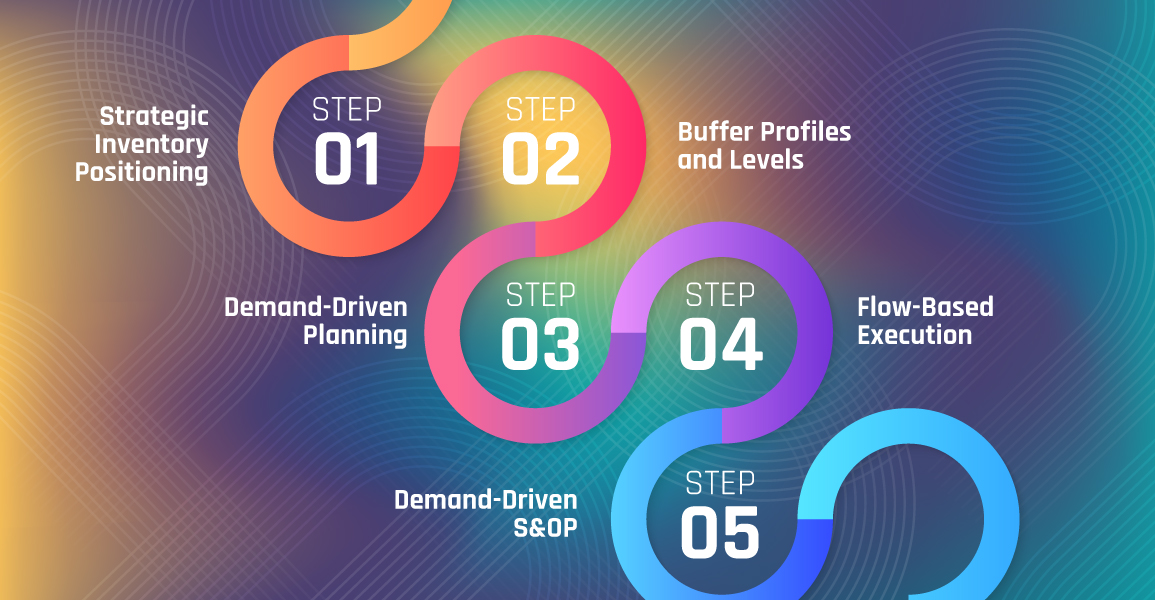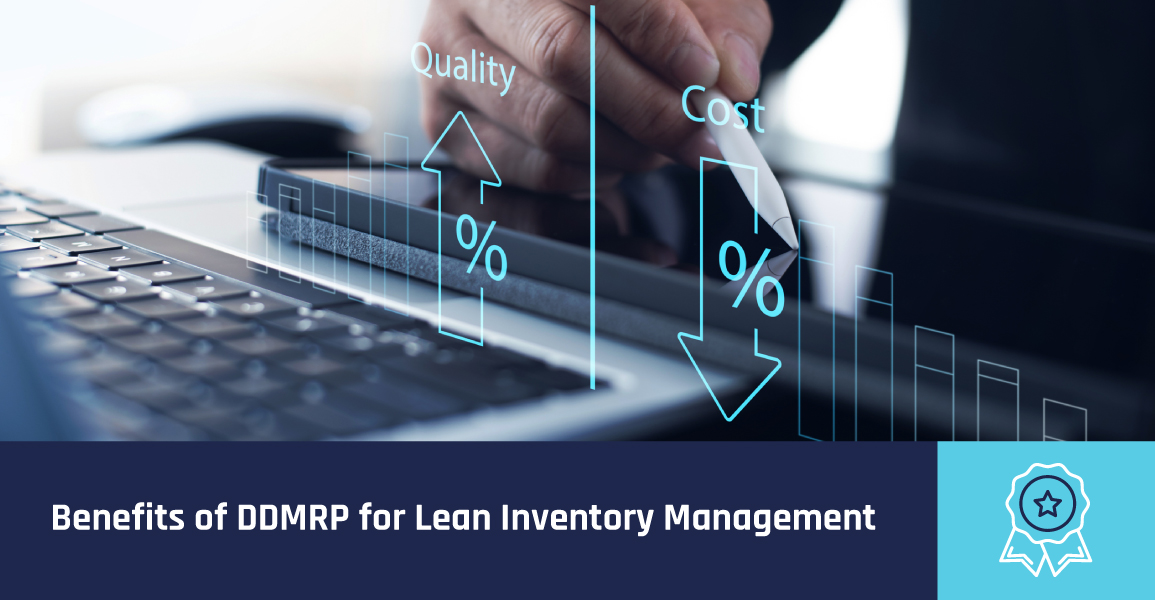
Embracing DDMRP: Liberating Your Supply Chain from Conventional Constraints for Unrivalled Agility
May 21, 2024
Innovation Activation: Driving Product Development with DDMRP
June 4, 2024In today’s competitive business environment, efficient inventory management is crucial for maintaining profitability and customer satisfaction. Lean inventory management aims to reduce waste and improve efficiency throughout the supply chain. Demand Driven Material Requirements Planning (DDMRP) is a modern methodology that enhances lean inventory management by focusing on actual demand rather than forecasts. This article explores the concept of lean inventory management and how DDMRP can serve as a catalyst for achieving lean supply chain objectives. Readers will gain insights into the key principles of DDMRP implementation, including buffer sizing, demand-driven planning, and flow-based execution, to minimise excess inventory while maintaining high service levels.
Understanding Lean Inventory Management
Lean inventory management is a systematic approach to managing stock that emphasises the reduction of waste and optimization of processes to create more value with fewer resources. Originating from the Toyota Production System, lean principles have been widely adopted across various industries to improve efficiency and reduce costs.
Key Principles of Lean Inventory Management
- Value: The first principle of lean inventory management is understanding what creates value for the customer. This involves identifying products and services that customers are willing to pay for and focusing resources on these value-adding activities. By prioritising what truly matters to the customer, companies can streamline their operations and eliminate activities that do not contribute to value, thereby reducing waste and costs.
- Value Stream: Mapping out the value stream involves a detailed analysis of all the steps involved in bringing a product from conception to the customer. This process helps identify areas where waste occurs, such as redundant processes, excess inventory, or unnecessary movement of materials. By visualising the entire supply chain, companies can pinpoint inefficiencies and take steps to streamline processes, ensuring that every step adds value to the final product.
- Flow: The principle of flow is about ensuring that the production process moves smoothly without interruptions. This involves designing processes that minimise delays and bottlenecks, allowing materials and products to move seamlessly through the production stages. A smooth flow reduces waiting times and increases the efficiency of the production system, enabling faster response to customer demands.
- Pull: In a pull-based system, production is driven by actual customer demand rather than forecasts. This means producing only what is needed, when it is needed. By aligning production closely with real-time demand, companies can avoid overproduction and excess inventory. This approach reduces inventory holding costs and ensures that resources are used efficiently.
- Perfection: The pursuit of perfection is a continuous process of identifying and eliminating waste. Companies strive for continuous improvement (kaizen) by regularly reviewing and refining their processes. This ongoing effort to enhance value and eliminate waste leads to incremental improvements that compound over time, resulting in significant efficiency gains and cost reductions.
By implementing these principles, companies can significantly reduce excess inventory, decrease lead times, and improve overall efficiency.

Introducing DDMRP: A Catalyst for Lean Supply Chain
DDMRP, developed by Carol Ptak and Chad Smith, is an innovative approach that integrates traditional Material Requirements Planning (MRP) with lean principles and modern supply chain strategies. Unlike conventional MRP systems that rely heavily on forecasts, DDMRP focuses on actual demand and uses strategic buffers to manage variability and uncertainty.
Core Components of DDMRP
- Strategic Inventory Positioning: Identifying critical points in the supply chain where inventory buffers should be placed.
- Buffer Profiles and Levels: Establishing dynamic buffer levels based on actual demand and variability.
- Demand-Driven Planning: Adjusting supply orders based on the consumption of buffer stocks.
- Visible and Collaborative Execution: Ensuring real-time visibility and collaboration across the supply chain to respond quickly to changes in demand.
- DDS&OP (Demand Driven Sales and Operations Planning): Aligning supply chain operations with business objectives and market demand.
Implementing DDMRP: Step-by-Step Guide
Implementing DDMRP involves several key steps that transform a traditional supply chain into a demand-driven one. Below, we will delve into the critical aspects of DDMRP implementation.
Step 1: Strategic Inventory Positioning
Strategic inventory positioning involves determining where to place inventory buffers within the supply chain to protect against variability and ensure smooth flow. This step is crucial for minimising disruptions and maintaining high service levels. It also determines how responsive the supply chain will be and the working capital investment necessary.
- Critical Points Identification: Identify points in the supply chain where inventory buffers will have the most significant impact. These points are typically where variability is highest or where lead times are longest.
- Decoupling Points: Establish decoupling points to separate different stages of the supply chain, allowing each stage to operate independently and more efficiently.

Step 2: Buffer Profiles and Levels
Once strategic points are identified, the next step is to define buffer profiles and levels. Buffers are categorised into three zones: green (safe), yellow (caution), and red (critical).
- Buffer Sizing: Calculate the appropriate size for each buffer based on lead times, demand variability, and service level targets.
- Dynamic Adjustments: Continuously adjust buffer levels based on actual consumption patterns and changes in demand.
Step 3: Demand-Driven Planning
Demand-driven planning shifts the focus from forecast-driven to actual demand-driven operations. This approach ensures that inventory levels are aligned with real-time consumption.
- Replenishment Triggers: Use buffer consumption to trigger replenishment orders. When inventory falls into the yellow or red zones, it signals the need for restocking.
- Net Flow Position: Monitor the net flow position, which is the difference between on-hand inventory and outstanding orders, to make informed replenishment decisions.
Step 4: Flow-Based Execution
Flow-based execution ensures that the supply chain responds promptly and effectively to changes in demand, maintaining a smooth flow of materials and products.
- Real-Time Visibility: Implement systems that provide real-time visibility into inventory levels, buffer statuses, and demand signals across the supply chain.
- Collaborative Response: Foster collaboration among supply chain partners to quickly address disruptions and changes in demand.
Step 5: Demand-Driven S&OP
Demand-driven Sales and Operations Planning (DDS&OP) integrates DDMRP principles into broader business planning processes, aligning supply chain operations with overall business objectives.
- Integrated Planning: Combine demand-driven planning with traditional S&OP processes to create a holistic approach to supply chain management.
- Continuous Improvement: Regularly review and adjust planning parameters based on performance metrics and market changes.
Benefits of DDMRP for Lean Inventory Management
Implementing Demand Driven Material Requirements Planning (DDMRP) offers several benefits that align with lean inventory management principles, helping organisations achieve a more efficient and responsive supply chain.
Reduced Inventory Levels
One of the primary benefits of DDMRP is the significant reduction in inventory levels. By focusing on actual demand rather than forecasted demand, DDMRP ensures that the organisation will only produce what is necessary to supply the market and no more. Materials are held in strategically positioned inventory buffers at critical points in the supply chain. These buffers are dynamically sized based on real-time data, which allows companies to maintain the optimal amount of stock necessary to meet customer demand without overproducing. This approach leads to lower carrying costs because less capital is tied up in excess inventory. Additionally, it minimises the risk of obsolescence, as products are less likely to sit in storage for long periods. The reduction in inventory levels also frees up warehouse space and reduces associated costs, such as storage and insurance, further enhancing cost efficiency.

Improved Service Levels
DDMRP improves service levels by ensuring that products are available when customers need them. This is achieved through dynamic buffer management, which adjusts inventory levels in response to changes in demand. Real-time visibility into inventory and buffer statuses allows companies to react swiftly to consumption patterns, preventing stockouts and ensuring timely replenishment. The strategic positioning of buffers at decoupling points in the supply chain decouples lead times, making the system more responsive to actual customer orders. Consequently, companies can maintain high service levels without holding excessive inventory, which not only meets customer expectations but also enhances customer satisfaction and loyalty.
Enhanced Agility
The enhanced agility provided by DDMRP is crucial in today’s fast-paced market environment. DDMRP enables supply chains to quickly respond to changes in demand, reducing lead times and increasing flexibility. This agility stems from the real-time adjustments in inventory buffers and the focus on actual demand signals. By decoupling supply chain stages, DDMRP allows each stage to operate independently yet cohesively, adapting rapidly to shifts in market conditions or customer preferences. This responsiveness helps companies mitigate risks associated with demand variability and disruptions, maintaining a steady flow of goods and services to the market. Enhanced agility not only improves operational performance but also provides a competitive advantage by enabling faster response to opportunities and challenges.
Better Collaboration
DDMRP fosters better collaboration among supply chain partners, facilitating improved communication and coordinated responses to demand fluctuations. By providing real-time visibility into inventory levels and buffer statuses, DDMRP enables all stakeholders to access the same information, promoting transparency and trust. This shared visibility allows suppliers, manufacturers, and distributors to synchronise their activities, ensuring that materials and products flow smoothly through the supply chain. Collaborative planning and execution help identify potential issues early, allowing for proactive resolution. This integrated approach reduces the bullwhip effect, where small changes in demand can lead to significant variability upstream, leading to more stable and efficient supply chain operations.
Increased Efficiency
Increased efficiency is a hallmark of DDMRP, achieved by minimising waste and optimising processes throughout the supply chain. By focusing on actual demand and strategically managing inventory buffers, DDMRP eliminates the inefficiencies associated with overproduction and excess inventory. The real-time adjustments in buffer levels ensure that resources are used effectively, reducing waste and improving throughput. This optimization extends to production scheduling and procurement processes, aligning them more closely with actual demand patterns. The result is a leaner, more efficient supply chain that can deliver products more reliably and cost-effectively. The cumulative effect of these improvements leads to significant cost savings and enhanced profitability, positioning companies for long-term success in a competitive marketplace.
Challenges and Considerations in Implementing DDMRP
While DDMRP offers numerous benefits, implementing it successfully requires careful planning and consideration of several factors.
Change Management
Transitioning to a demand-driven approach requires a significant cultural shift within an organisation. Employees must receive training on DDMRP principles and practices, which may differ considerably from traditional inventory management methods. This shift involves fostering a deep understanding of how DDMRP enhances efficiency and why it is crucial for the company’s success. Management should actively promote and support this change, ensuring alignment among all stakeholders. Effective communication is critical to address resistance and build consensus around the benefits of adopting DDMRP. Ongoing training and development keep employees updated on best practices and new developments, ensuring sustained success.

Data Accuracy
In the context of DDMRP, data accuracy plays a critical role in effective buffer management and demand-driven planning. When data is inaccurate, it can lead to improper buffer sizing, misaligned inventory levels, and overall supply chain inefficiencies. To address this, companies should invest in robust systems and processes that ensure data integrity and real-time visibility. Implementing advanced inventory management software, upgrading IT infrastructure, and establishing rigorous data validation protocols are essential steps. Accurate, timely data enables precise adjustments to buffer levels and more responsive replenishment strategies, closely aligning inventory with actual demand. Without high-quality data, the full benefits of DDMRP cannot be realised, and the risk of stockouts or excess inventory remains significant.
System Integration
Integrating DDMRP with existing Enterprise Resource Planning (ERP) and supply chain management systems is less complex and resource-intensive than one may think, as leading DDMRP software vendors have invested intensively in the development of standard interface protocols to most ERP systems. The key considerations for successful integration include:
- Seamless Integration: Achieving seamless integration ensures that relevant data flows smoothly between systems, enabling real-time updates and coordination. This is critical for leveraging the full benefits of DDMRP.
- IT Investments: For most companies DDMRP can be implemented without any significant IT investment, as most leading DDMRP software are Software as a Service (SaaS). Some external consulting services may be necessary to navigate the complexities of integration.
- Careful Planning and Execution: Thorough planning and execution are essential to minimise disruptions to ongoing operations. Phased implementation and rigorous testing help mitigate risks associated with system integration.
- User-Friendly Systems and Training: Ensuring that integrated systems are user-friendly and that staff receive adequate training is crucial for successful adoption.
Remember, a well-executed integration enhances efficiency and streamlines supply chain processes. The Return on Investment (ROI) of a DDMRP implementation project is determined primarily by the speed and quality of the implementation, much less by its cost.
Conclusion
Incorporating DDMRP into lean inventory management practices can significantly enhance supply chain efficiency, reduce waste, and improve service levels. By focusing on actual demand and strategic buffer management, companies can achieve a more responsive and agile supply chain. While the implementation of DDMRP requires careful planning and ongoing commitment, the benefits it offers make it a valuable tool for organisations striving to achieve lean supply chain objectives.
Optimise your inventory management with DDMRP’s efficiency. Get in touch to maximise your operations!




